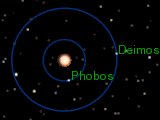Mars Moon-Based Habitats
|
|
Humanity might eventually establish a presence at the planet, Mars. The long term goal might be to terraform Mars and establish a permanent population. During the lengthy terraformation, humans may have to live in sub-surface facilities. However, a short term goal might be to establish habitats near the Martian moons, Phobos and Deimos.
Phobos is the innermost moon. with a period of 7.65 hours, it orbits Mars four times during one orbit of Deimos. At only 9,378 km, it is too close be seen daily from all points on Mars's surface. Observations indicate the surface is mainly powder due to eons of meteoroid impacts. |  | Deimos circles Mars every 30 hours at 23,459 km from Mars. Though heavily cratered, "ejecta" escaped to space due to lesser mass & gravity of Deimos. Thus, thick regolith is exposed to view without the powder observed on Phobos. |

Phobos Basic Dimensions
27 by 22 by 18 km
Mass = 10.65x1012 mT
|
 Possible Habitat Dimensions. Radii and corresponding rotation rates, from O’Neill’s “High Frontier”. Est. mass =3x105 mTs.
Possible Habitat Dimensions. Radii and corresponding rotation rates, from O’Neill’s “High Frontier”. Est. mass =3x105 mTs. 
Deimos Basic Dimensions
15 by 12 by 11 km
Mass= 2.4x1012 mT
Mars Moon-Based Habitats
Humanity might initiate their presence on Mars by orbiting habitats in vicinities of Deimos and Phobos. These moon based habitats could be excellent way stations for exploration of their host planet. Habitat dimensions would vary according to need and are discussed further below.
Colonization. The term, colony, implies financial gain from resource exploitation. This conjures up images of mining rare exotic substances on Mars and sending them back to Earth for large financial profits. Unlikely, even if we found the most expensive substance known to mankind (jewels?, platinum??) cost of transporting it back to Earth would far exceed it's intrinsic value.Martian network of habitats. Terraforming Mars will take many years if not centuries. Until Mars obtains an human friendly environment, thought experiment proposes following:
Habitats at moons could be rotate at rotational speed to produce 1-g centripetal force, thus, moon habitats could simulate Earth's environment fairly closely.
Surface and subsurface Martian habitats will incorporate a combination of large transparent domes to contain manufactured Earth-surface like atmosphere and admit sunlight (likely concentrated sunlight from orbiting mirrors) could simulate many aspects of Terra; it's unlikely that Earth surface gravity will ever be one of them. It's likely that many people will choose to live permanently on one of the habitats; because staying accustomed to 1-g will facilitate eventual return to Earth where years of accumulated wealth from a Mars assignment will present many opportunities.
On the other hand, if circumstances and/or choice compels some to live permanently on Mars, their bodies will grow accustomed to Martian gravity. Those people will be "de facto" Martians and will eventually become a permanent population of Mars. Likely benefits from posting next to the moons include following:
- Construction materials. Thought experiment estimates habitat’s mass as same size of large ocean going vessel, perhaps 3x105 mTs. Since Martian moons have many, many thousands times that much mass, thought experiment assumes plenty of material for further construction.
- Basis for trade. Martian moons could be surveyed, assayed, mined and exploited to the max. With any luck, different materials at the two moons could be a source of commerce between the two habitats.
- Moon as Marker. Excellent NavAid.
- Namesake. For discussion's sake, this thought experiment assumes that each habitat will take on the name of it's host moon.
- Perhaps most useful benefit might be artificial gravity. If able to build a large “Island Three” type structure with a radius of 3.6 km, Earth surface gravity would require 3° per second rotation about the longitudinal axis. It so happens that 3°/sec is just below the average human’s perception of platform rotation. More to explore w.r.t. environmental rotation perception: http://www.hfes.org/Web/
Habitats can be very comfortable "homes" during lengthy flights. As a matter of fact, habitats might be necessary for the several years required for trips to other planetary systems: Jupiter and moons, Saturn and rings and moons, Uranus....., Neptune.....
Cyclers. Some habitats will cycle between Earth's orbit and orbits of other planets. (This cycle is actually another Solar orbit.) Cycler trips will take months, but the travel conditions will be excellent (like living at home or better). They'll be so big that the spin around the longitudinal axis won't be noticed, but this spin will produce an Earth like gravity. They'll have their own fields, forests, jungles, rivers or any environment that enterprise perceives a market for.
Orbiters. Some habitats will orbit neighboring planets. Often, these orbits will be in conjunction with existing moons. Eventually, orbiters will be "towed" by powerful, g-force ships to their orbiting destination; such trips will take only days. However, this chapter discusses the near time future where we haven't yet gained that capability
Combine the "cycler" and "orbiter" concepts. Until we have g-force spacecraft with "towing" capability, going to Mars will require orbiters to spend years/months via transfer orbits. During this lengthy trip, this large cylindrical structure will impact Earth like gravity to occupants via carefully controlled spin about its longitudinal axis. It's very likely the habitats, Deimos and Phobos, will use transfer orbits to get to Mars and eventually link up with their namesake Martian moons. Thus, an effective way to transport habitats from Earth orbit to Mars orbit will be for habitat to be a cycler for one half of a carefully planned orbit; then, join up with new host and become an orbiter at destination.


0 Comments:
Post a Comment
<< Home